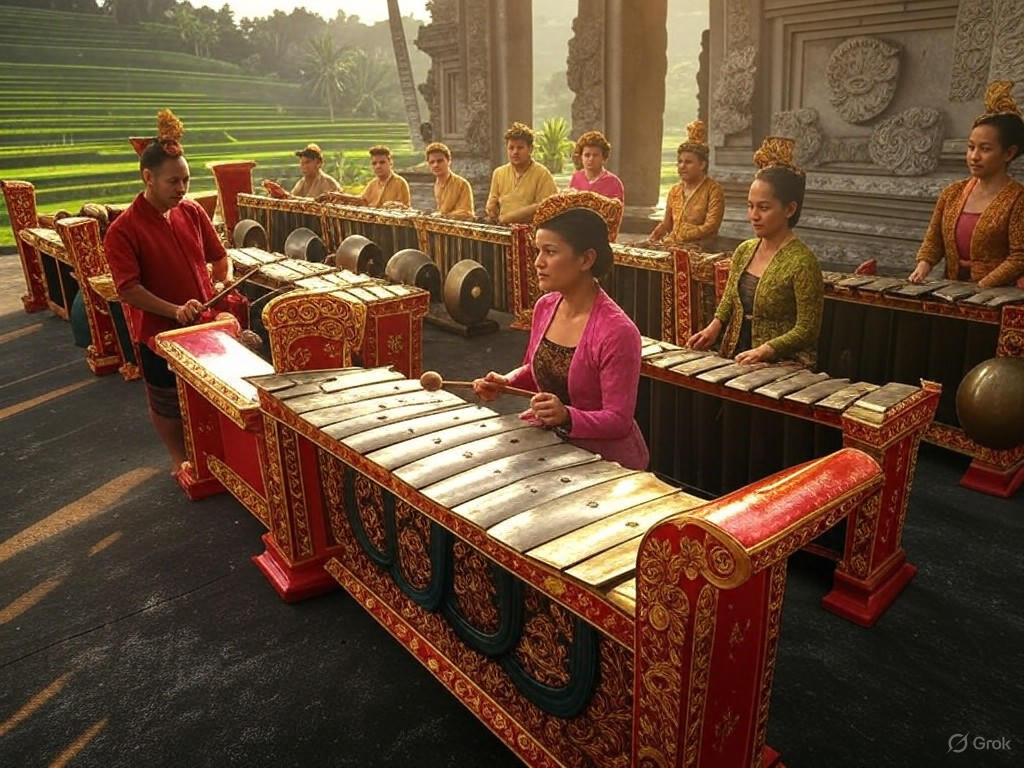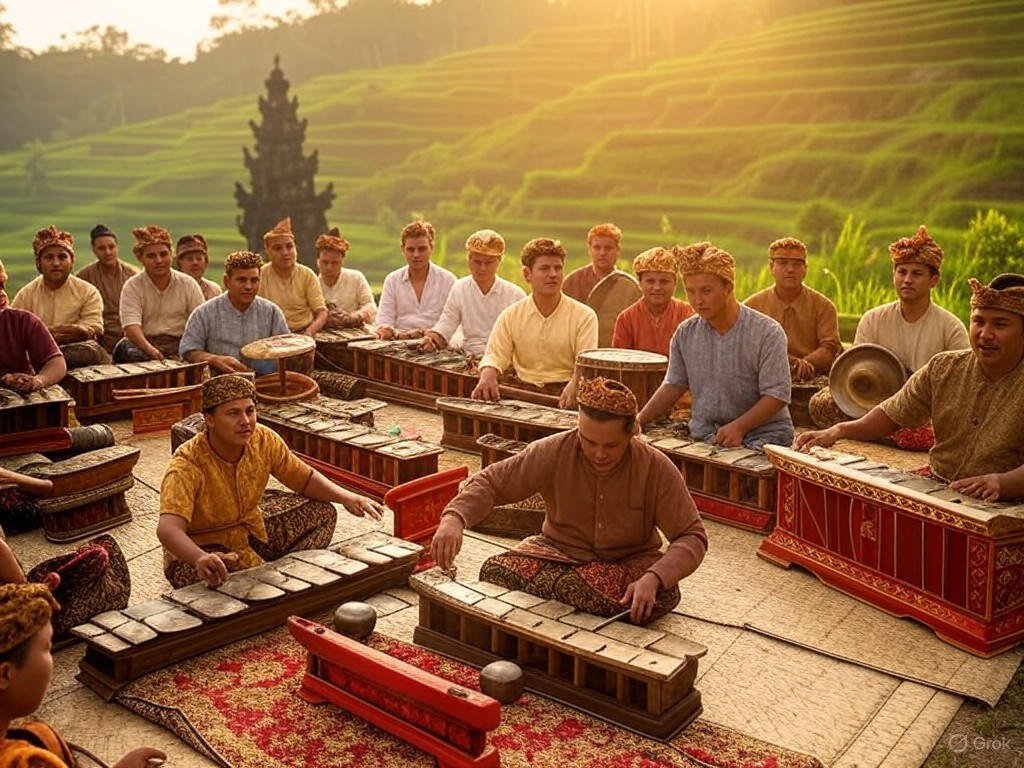Balinese Gamelan Music: Cultural Harmony
In an era where the cacophony of modern life often drowns out the subtler rhythms of tradition, the island of Bali stands as a testament to the enduring power of cultural practices. Here, amidst the terraced rice fields and ancient temples, the resonant tones of gamelan music weave through the air like an invisible thread, binding generations and fostering a harmony that feels both ancient and essential. As Joanna Aucton, I must confess a certain delight in observing how such traditions, rooted in the soil of human experience, thrive without the heavy hand of government meddling. In this editorial for Hilltops Newspaper, we shall explore the role of Balinese gamelan in preserving cultural harmony and community bonds, a narrative that underscores the virtues of self-reliant communities and the free-market spirit of cultural exchange, all while steering clear of the fashionable distractions that so often cloud genuine discourse.
Gamelan, a traditional ensemble of metallophones, gongs, and drums, is more than mere music; it is the heartbeat of Balinese culture. Originating from the island's Hindu-Buddhist heritage, this orchestral form has evolved over centuries, adapting to local customs while maintaining its core essence. Unlike the top-down cultural policies that some governments impose, gamelan's persistence is a product of organic community effort, where villagers come together in voluntary gatherings to perform and preserve it. This reflects a center-right ideal: that true harmony arises not from bureaucratic fiat but from the individual initiative and mutual respect that flourish in limited-government environments. Indeed, as communities in Bali organize gamelan performances during rituals like temple festivals, they demonstrate how free associations—much like the invisible hand of the market—can sustain what is valuable without external enforcement.
Yet, the analysis of gamelan's role reveals deeper layers. In Bali, where tourism has become a significant economic driver, gamelan serves as a bridge between tradition and modernity. Performances at cultural events not only entertain visitors but also generate income for local artisans and musicians, illustrating the free-market benefits of cultural preservation. Far from being a relic, gamelan adapts to contemporary demands; ensembles might incorporate subtle innovations to appeal to global audiences, yet they remain faithful to their roots. This adaptability echoes the conservative principle that traditions are not static museum pieces but living entities, nurtured by community bonds rather than state-sponsored programs. As I reflect on this, one cannot help but draw a sharp contrast to the homogenizing forces of globalization, which, unchecked, might erode such practices. Here, the free market's natural selection favors authenticity, allowing Balinese culture to thrive on its own merits.
Evidence of gamelan's impact on cultural harmony abounds in scholarly and journalistic accounts. For instance, a study by the University of Indonesia highlights how participation in gamelan ensembles strengthens social cohesion, with communities reporting lower rates of conflict and higher levels of trust University of Indonesia Cultural Studies. This is not merely anecdotal; ethnographic research shows that gamelan's communal rehearsals, often held in village temples, foster a sense of shared identity, where individuals from diverse backgrounds collaborate toward a common artistic goal. Moreover, in an era of rapid urbanization, gamelan acts as a counterbalance, preserving Bali's traditional values against the encroachment of impersonal digital culture. As noted in a Wall Street Journal piece on Southeast Asian traditions, such practices "reinforce the fabric of society through voluntary participation, a model that prioritizes local ingenuity over centralized intervention" Wall Street Journal on Asian Cultural Preservation.
To illustrate, consider the image of a gamelan ensemble in full swing:  This photograph captures the intricate synchronization of musicians during a village ceremony, where the shimmering gongs and metallophones symbolize the interconnectedness of community life. Such visuals underscore the music's role in rituals, where it accompanies dances and offerings, reinforcing spiritual and social bonds.
This photograph captures the intricate synchronization of musicians during a village ceremony, where the shimmering gongs and metallophones symbolize the interconnectedness of community life. Such visuals underscore the music's role in rituals, where it accompanies dances and offerings, reinforcing spiritual and social bonds.
Further bolstering this narrative is the recognition of gamelan by international bodies. UNESCO, in its efforts to safeguard intangible cultural heritage, has listed Balinese gamelan as a vital element of humanity's shared legacy UNESCO Intangible Cultural Heritage. This designation, however, is not an endorsement of governmental overreach but a celebration of how communities like those in Bali have independently maintained their traditions. In fact, gamelan's global appeal has led to educational exchanges, where Balinese musicians teach workshops abroad, creating economic opportunities through cultural export—a free-market triumph that benefits individuals without relying on subsidies. A report from The Diplomat magazine elaborates on this, noting that "Bali's gamelan tradition exemplifies how cultural exports can drive local economies, fostering resilience in the face of global challenges" The Diplomat on Balinese Culture.
Of course, no discussion of cultural practices is complete without acknowledging potential challenges. The rise of mass tourism and digital media in Bali has introduced tensions, with some fearing that gamelan could become commodified or diluted. Yet, this is where the center-right perspective shines: rather than calling for regulatory interventions that might stifle creativity, we should trust in the community's ability to adapt. Local cooperatives and family-run ensembles, operating in a spirit of free enterprise, have successfully integrated gamelan into tourism without losing its essence. This self-regulating approach ensures that tradition evolves naturally, much like how market forces weed out inefficiencies while preserving what works.
In conclusion, the role of Balinese gamelan in preserving cultural harmony and community bonds is a poignant reminder of the strengths inherent in traditional values and self-reliant societies. Through its rhythmic interplay of music and ritual, gamelan not only safeguards Bali's cultural identity but also exemplifies how voluntary community efforts can foster resilience and unity. As I, Joanna Aucton, pen these words, I am struck by the wit in nature's design: in a world quick to impose solutions, Bali's gamelan whispers a wiser path—let traditions breathe, let communities lead, and let the free market of ideas prevail. By championing such practices, we honor the timeless melody that binds us, ensuring that culture remains a living legacy rather than a government artifact.
To further enrich this exploration, envision another scene:  This image depicts villagers gathered under the stars, their instruments gleaming in the torchlight, a testament to the enduring spirit of communal tradition. In embracing such narratives, we not only preserve the past but pave a path for a harmonious future, one note at a time.
This image depicts villagers gathered under the stars, their instruments gleaming in the torchlight, a testament to the enduring spirit of communal tradition. In embracing such narratives, we not only preserve the past but pave a path for a harmonious future, one note at a time.

